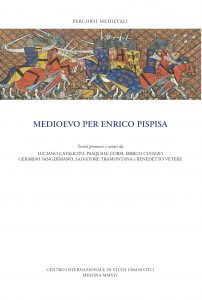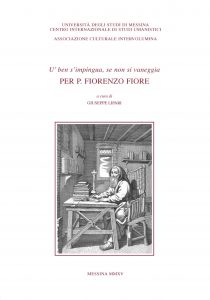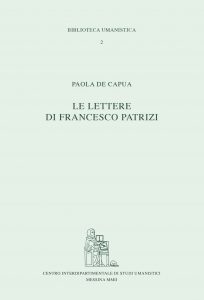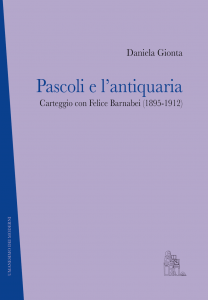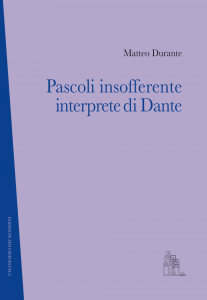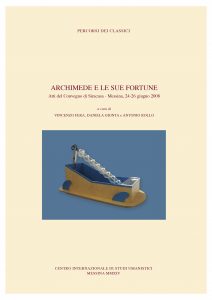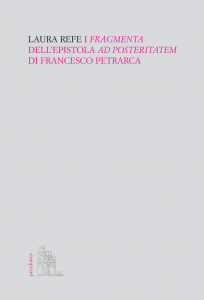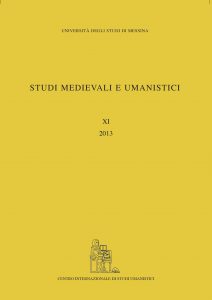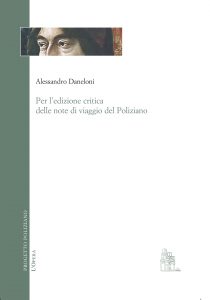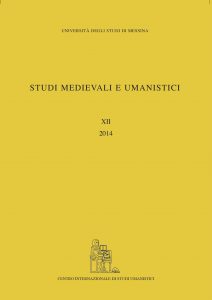
XII (2014)
Messina, Centro Internazionale di Studi Umanistici, 2014, 280 pp., tavv. XX; 25 cm.
ISSN 2035-3774
€ 120
INDICE GENERALE
Caterina Malta, Storici e storia nella riflessione petrarchesca. Il problema del canone
Monica Berté – Silvia Rizzo, «Valete amici, valete epistole»: l’ultimo libro delle Senili
Giovanni Cascio, Sul destinatario di Sine nomine 14: l’arcivescovo Arnošt z Pardubic
Dániel Kiss, Ludovico Regio, Giovanni Luchino Corti and Manilio Cabacio Rallo
Luigi Orlandi, Baldassar Migliavacca lettore e possessore di codici greci
Antonino Antonazzo, Ecdotica e interpretazione in un dictamen del giovane Boccaccio (Epist. IV)
TESSERE
A. Bellieni, «Lux altera Rome». Scipione l’Africano Minore in un carme di Francesco da Fiano
L. Orlandi, Sette nuovi manoscritti copiati e annotati da Demetrio Castreno
A. Tura, Jean Lemaire de Belges tra le letture di Ariosto?
RECENSIONI
R. Badalì, Carmina medicalia (A. M. Urso)
Indice delle tavole
Indice dei manoscritti e delle fonti d’archivio
Indice dei nomi
ABSTRACT
CATERINA MALTA, Storici e storia nella riflessione petrarchesca. Il problema del canone
By drawing on some marginalia in the ms. Par. lat. 5816 of the Historia Augusta where Petrarch seems to create a hierarchy of auctores for the historiographic genre, the paper sets out to investigate the idea of ‘tradition’ for the humanist. One of the aims of the present study is also to put into question the possibility of using the category of ‘canon’ as an epistemological key. The paper thus analyses the speculative range of those list of authors that are found in Petrarch’s work and that have been categorised by quoting the notion of ‘canon’, in particular some specific places of the Familiari, the list of peculiares written by young Petrarch in the ms. Par. lat. 2201 and the catalogue of the historians of the third Tr. Fame.
MONICA BERTÉ – SILVIA RIZZO, «Valete amici, valete epistole»: l’ultimo libro delle Senili
It is generally assumed that Petrarch planned to put at the end of the Seniles the Epistola ad Posteritatem, thereby creating a symmetry with the last Book of the Familiares, which was made up of letters to great men of the past. The paper aims to prove that towards the end of his life Petrarch abandoned this project: sensing that, in his frail health, death was imminent, he judged that the Book XVII – with the famous translation of the last tale in the Decameron – was especially apt to conclude the collection. So he wrote the last letter, Sen. XVII 4, ending with a definitive farewell to friends and letters. The outcome is that it is not correct to print – as recent editors have done – the unfinished letter Ad Posteritatem as Book XVIII of the Seniles. The study of the tradition makes it possible to demonstrate that a difficult passage of Sen. XVII 4, concerning the question of whether the tale of Griselda be history or fable, was never correctly printed, and that the restitution of the wording with appropriate punctuation brings the passage into line with others where Petrarch considers the same problem. The paper also deals with question about Petrarch and the Decameron: how and when he had a copy of it and whether it was ever talked of between the two friends.
GIOVANNI CASCIO, Sul destinatario di Sine nomine 14: l’arcivescovo Arnošt z Pardubic
One of the most distinctive features of Petrarch’s Liber sine nomine is the cautious elimination of the names of the recipients from the 19 letters which form the collection. The article deals mainly with the identification of the addressee of Sine nom. 14. On the grounds of its contents and of some thematic similarities with Fam. XXI 1, addressed on the 29th April 1357 to Arnošt z Pardubic, archbishop of Prague, the A. demonstrates that the letter was delivered together with Fam. XXI 1, on the same day and to the same recipient by Sagremor de Pommiers, Petrarch’s friend and messenger at the service of the Visconti family. Furthermore, a reference in Fam. XXI 1 to some potentially dangerous political writings, to be identified as the first core of the Liber, casts light on the ‘prehistory’ of the antipapal collection.
DÁNIEL KISS, Ludovico Regio, Giovanni Luchino Corti and Manilio Cabacio Rallo
The introductory epigram of Berlin, Staatsbibliothek, MS. Hamilton 561, the presentation copy of a collection of poems by Manilio Cabacio Rallo (c. 1447 – c. 1522), suggests that the volume was copied by Giovanni Luchino Corti. This article argues that in fact the codex was copied by Ludovico Regio. It offers an account of Regio’s life and a list of the manuscripts that he copied or annotated, and it tries to cast light on his collaboration with Luchino Corti.
LUIGI ORLANDI, Baldassar Migliavacca lettore e possessore di codici greciI
The article aims to reconstruct the manuscript collection of Baldassar Migliavacca, a little-known humanist who was in touch with prominent personalities of his time, such as Pico della Mirandola and Ermolao Barbaro. The paleographical study of Migliavacca’s Greek handwriting proves that he was a pupil of the Byzantine scholar Andronicus Callistus. Several annotations in his hand can be found in many of his teacher’s books and in other manuscripts, and shed light on his philological activity on Greek classical texts.
ANTONINO ANTONAZZO, Ecdotica e interpretazione in un dictamen del giovane Boccaccio (Epist. IV)
In this study on Boccaccio’s Epist. IV the A. deals with the fictitious nature of the letter and its addressee. He also corrects the current vulgate text in six places solving problems related to language, handwriting, punctuation and literary sources.
A. BELLIENI, «Lux altera Rome». Scipione l’Africano Minore in un carme di Francesco da Fiano
This article presents the poem by Francesco da Fiano, inc. «Altera lux patrie nitet», whose protagonist is known as Scipio Africanus the Younger. The A. suggests that the poet wrote the text for Palazzo Trinci mural paintings in Foligno. The contribution, besides providing a critical edition of the poem, analyses its literary sources and quotations from ancient and modern authors, such as Petrarch.
L. ORLANDI, Sette nuovi manoscritti copiati e annotati da Demetrio Castreno
This article provides new data on the activity of the Byzantine scholar Deme trius Castrenus, previously known as Anonymus ου-π Harlfinger. Seven new manuscripts copied and annotated by him are here presented.
A. TURA, Jean Lemaire de Belges tra le letture di Ariosto?
The author suggests that Ludovico Ariosto might have been acquainted with Jean Lemaire’s prosimetrum La Plainte du désiré. Moreover, the earliest Paris editions of this work bear on the title-page a woodcut with Lemaire’s coat of arms and multiple devices, one of which seems to have inspired Ariosto in conceiving his own impresa with bees.
